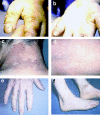Connexin mutations in skin disease and hearing loss
- PMID: 11179004
- PMCID: PMC1274469
- DOI: 10.1086/318803
Connexin mutations in skin disease and hearing loss
Figures



References
Electronic-Database Information
-
- Connexin-Deafness Homepage, The, http://www.iro.es/cx26deaf.html
-
- Hereditary Hearing Loss Homepage, http://dnalab-www.uia.ac.be/dnalab/hhh/
-
- Online Mendelian Inheritance in Man (OMIM), http://www.ncbi.nlm.nih.gov/Omim/ (for Vohwinkel syndrome [MIM 124500], DFNA3 [MIM 601544], EKV [MIM 133200], GJB2 [MIM 121011], DFNB1 [MIM 220290], HED [MIM 129500], GJB3 [MIM 603324], GJB6 [MIM 604418], and palmoplantar keratoderma with deafness [MIM 148350])
References
-
- Bale SJ, White TW, Munro C, Taylor AEM, Richard G (1999) Functional defects of Cx26 due to mutations in two families with dominant palmoplantar keratoderma and deafness. J Invest Dermatol 112:A550
-
- Cao F, Eckert R, Elfgang C, Nitsche JM, Snyder SA, DF Hu, Willecke K, Nicholson BJ (1998) A quantitative analysis of connexin-specific permeability differences of gap junctions expressed in HeLa transfectants and Xenopus oocytes. J Cell Sci 111:31–43 - PubMed
-
- Choudhry R, Pitts JD, Hodgins MB (1997) Changing patterns of gap junctional intercellular communication and connexin distribution in mouse epidermis and hair follicles during embryonic development. Dev Dyn 210:417–430 - PubMed
-
- Cohn ES, Kelley PM, Fowler TW, Gorga MP, Lefkowitz DM, Kuehn HJ, Schaefer GB, Gobar LS, Hahn FJ, Harris DJ, Kimberling WJ (1999) Clinical studies of families with hearing loss attributable to mutations in the connexin 26 gene. Pediatrics 103:546–550 - PubMed
Publication types
MeSH terms
Substances
LinkOut - more resources
Full Text Sources
Medical

